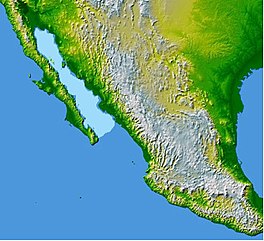| Gulf of California | |
|---|---|
| Sea of Cortés, Vermilion Sea | |
 Gulf of California (highlighted in light blue) | |
| Coordinates | 28°0′N 112°0′W / 28.000°N 112.000°W |
| River sources | Colorado, Fuerte, Mayo, Sinaloa, Sonora, Yaqui |
| Ocean/sea sources | Pacific Ocean |
| Basin countries | Mexico |
| Max. length | 1,126 km (700 mi) |
| Max. width | 48–241 km (30–150 mi) |
| Surface area | 160,000 km2 (62,000 sq mi) |
| Islands | 37 |
| References | [1] |
| Official name | Islands and Protected Areas of the Gulf of California |
| Type | Natural |
| Criteria | vii, ix, x |
| Designated | 2005 |
| Reference no. | 1182 |
| Region | Latin America and the Caribbean |
| Endangered | 2019–present[2] |
The Gulf of California (Spanish: Golfo de California), also known as the Sea of Cortés (Mar de Cortés) or Sea of Cortez, or less commonly as the Vermilion Sea (Mar Vermejo), is a marginal sea of the Pacific Ocean that separates the Baja California peninsula from the Mexican mainland. It is bordered by the states of Baja California, Baja California Sur, Sonora, and Sinaloa with a coastline of approximately 4,000 km (2,500 mi). Rivers that flow into the Gulf of California include the Colorado, Fuerte, Mayo, Sinaloa, Sonora, and the Yaqui. The surface of the gulf is about 160,000 km2 (62,000 sq mi). Maximum depths exceed 3,000 meters (9,800 ft) because of the complex geology, linked to plate tectonics.[3]
The gulf is thought to be one of the most diverse seas on Earth and is home to more than 5,000 species of micro-invertebrates.[4] Parts of the Gulf of California are a UNESCO World Heritage Site.
- ^ Cite error: The named reference
Nixwas invoked but never defined (see the help page). - ^ Cite error: The named reference
whs dangerwas invoked but never defined (see the help page). - ^ Richard C. Brusca (1973). A Handbook to the Common Intertidal Invertebrates of the Gulf of California. Tucson, Arizona: University of Arizona Press. pp. 10–15. ISBN 978-0-8165-0356-8.
- ^ Ernesto Campos, Alma Rosa de Campos & Jesús Angel de León-González (2009). "Diversity and ecological remarks of ectocommensals and ectoparasites (Annelida, Crustacea, Mollusca) of echinoids (Echinoidea: Mellitidae) in the Sea of Cortez, Mexico". Parasitology Research. 105 (2): 479–487. doi:10.1007/s00436-009-1419-8. PMID 19337754. S2CID 19481500.